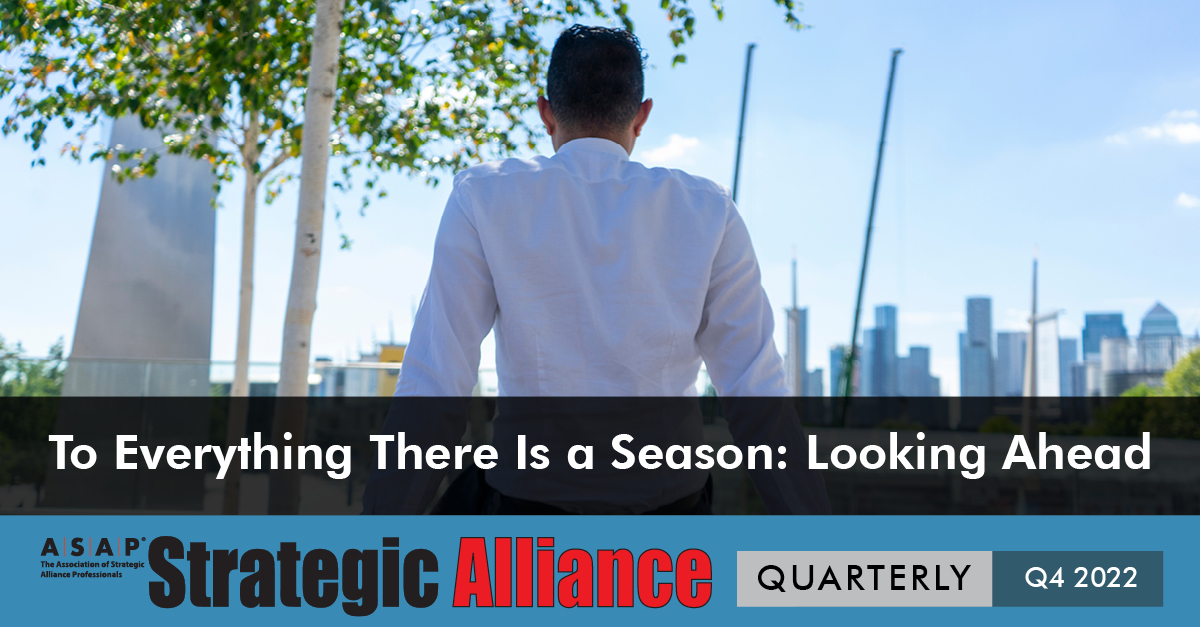To Everything There Is a Season: Looking Ahead
As we settle into a new year, it’s always interesting to look back for a moment as well. As I think about 2022, I’m amazed at how many people we were able to touch and connect with, both in person and virtually. I don’t know the exact number, but it’s in the hundreds, if not thousands! I’m always thankful for these connections, and I’m doubly, even triply, grateful that we have returned to hosting our in-person conferences—three of them! And 2023 promises more of the same, only bigger and better.
One of the great things about the conferences last year was seeing so many new faces—most notably at the record-breaking ASAP BioPharma Conference in Boston last September, but also at the Global Alliance Summit in Tampa last April and the European Alliance Summit in Amsterdam last October. It’s yet another hopeful sign for the future of our partnering profession, and it’s nice to know that others are now coming along to carry the torch of alliance management that was lit almost 25 years ago and has been held aloft all this time by our ASAP member community.
Three Emerging Trends
Which leads me into three general trends I’ve seen emerge more clearly over the past year:
- Waves of alliance change. New people in the profession (many of them attending our ASAP events!), new alliance leaders, new alliance groups (some of them reengineered and then reconstructed, as I noted in last issue’s column), new companies, and even new industries where the practice of partnering is steadily gaining ground.
- Ecosystem management takes center stage. A number of our ASAP thought leaders have written about it, and we’ve interviewed many others to get their perspectives. ASAP webinars have featured fascinating discussions of it. But there’s no clear consensus yet about how best to manage ecosystems—or whether they can even be managed at all. Some of our tech partnering colleagues speak instead about the “orchestration” or “curation” of ecosystems. Whatever the case, it’s certainly true that a vast constellation of hundreds or even thousands of partners simply cannot be “managed” the way a one-to-one alliance might be—or even a go-to-market partnership involving several companies playing different roles. Ecosystems aren’t new, but there’s still much to be learned about how to optimize them in order to maximize value creation for all.
- Healthcare and information technology are coming together as partners—and that’s a good thing. When I say “healthcare” I include our biopharma and life sciences companies as well as the many other suppliers, providers, patient advocacy groups, venture capital firms, and others throughout this vast ecosystem (there’s that word again). We’ve already seen some of the tech giants try to break into healthcare—with mixed results. But better outcomes may ultimately be in store, as pharma companies are busy partnering with tech and digital health startups (the subject of an article in the Q4 2022 issue of our magazine, Strategic Alliance Quarterly, “Crossing the Divide,” by Editor in Chief Michael J. Burke). It’s a rapidly evolving space where everyone’s trying to figure out the surest routes to success, but as in all true partnerships, each side must bring what it does best to the table while seeking to understand and leverage the strengths and capabilities of the other.
A Burning Need for the Fundamentals
In each of these three areas—the challenges brought by change, the management of ecosystems, and the convergence of tech and healthcare—there’s a burning need for the application of alliance management fundamentals. There’s also a need for being flexible in our thinking and open to new and different solutions. That’s the collaborative mindset—and without it, these partnerships just won’t work.
Fortunately there are many bright and good people working in all these areas and bringing their best alliance innovations to bear on the challenges. They recognize that there’s a golden, untapped opportunity here—not just to monetize something new and untested, but to bring better solutions and alternatives to customers, consumers, patients, and society at large.
And wherever these efforts are taking place, wherever alliances are getting more traction, ASAP’s campaign to spread the word about partnering best practices and principles will be needed, maybe now more than ever.
The Mission Continues
The challenges are many, but amid the waves of change and all the new developments that seem to hit us one after the other every day, we at ASAP recognize that our educational and career advancement mission must continue—and must continue to evolve. And it will.
Learning the fundamental principles of alliance management is one level—and through our workshops, master classes, publications, webinars, and conferences, we’re staying the course on that. But since change is a constant, all of us need to prepare ourselves to make the leap into the world of tomorrow. What will alliances, partnerships, and ecosystems look like in 2023? Or 2030? We’ll soon find out—and probably sooner than we think.
Meanwhile, I’m wishing you, your colleagues, partners, and families the very best in 2023—and thank you for making 2022 a great comeback year for ASAP!
Michael Leonetti, CSAP, is the president and CEO of the Association of Strategic Alliance Professionals (ASAP). A version of this post appeared as the Up Front column in Strategic Alliance Quarterly, Q4 2022.

